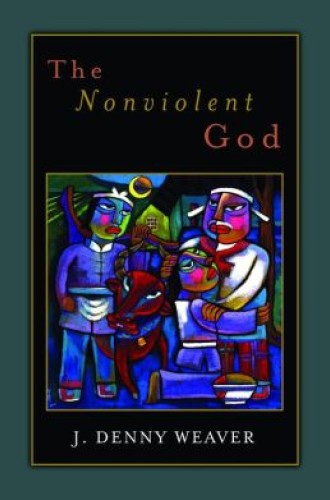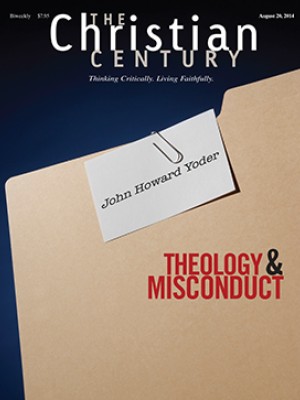The Nonviolent God, by J. Denny Weaver
Violence sells. Take a trendy teen novel featuring beautiful youths pitted against each other in mortal combat, adapt it to the big screen, and you will have a blockbuster on your hands. Organize a team of men or women who are willing to risk bodily injury in their pursuit of athletic glory, and the fans not only will come, they will empty their wallets and clamor for more. American culture has long assumed that the vitality of our economy is dependent on our ability to maintain a strong and mobile fighting force, so few people object to the allocation of a significant portion of our tax dollars to the building of weapons whose primary purpose is to kill and to maim. Indeed, there is a tacit assumption that violence is simply unavoidable. It is the way of the world, we say, and it is sometimes necessary if peace and prosperity are going to prevail. Anyway, violence sells, and anything that keeps our economy moving can’t be all bad.
So yes, violence sells, but does it save? It is the way of the world, but does it reflect the character of God as revealed in Christ? If not, shouldn’t we question its place in the traditional theology of the church?
These are the concerns at the heart of J. Denny Weaver’s book, which is a more systematic elaboration of a topic introduced in his earlier work The Nonviolent Atonement. Weaver is convinced that the divinely sanctioned violence featured in the church’s atonement models—especially the Christus Victor, satisfaction, and substitutionary views—is a regrettable diversion from the original message of Jesus. He bases his conclusion on a hermeneutical model that he refers to as the “narrative Christus Victor,” which affirms that God’s love for the world is most clearly demonstrated not in Christ’s suffering on the cross but in Jesus’ resurrection: God’s victory over death and the powers of evil in the world.
Read our latest issue or browse back issues.
That the church later came to use a ghastly tool of empire—the cross—to represent God’s perfect love for creation is one of the great tragedies of the faith. God is on the side of life, Weaver argues, and this is most clearly revealed in the person of God’s Son, who, as Luke and John attest, refused the sword and sought always to resolve conflict peacefully. If we were to try to establish our argument on the example of Jesus alone, we could in no way justify the notion, so central to later theological formulations, that God works redemptively through violence.
This is where many readers will take exception to Weaver’s approach. Relying on the life, death, and resurrection of Jesus as the primary means by which we can come to know the true character of God will strike many as a blatant disregard for the authority of scripture. Weaver is aware of this criticism but remains steadfast in his conviction that any conception of God found in the pages of the Old and New Testaments must first be compared to the person of Christ himself, and where there are discrepancies, the benefit of the doubt must go to God’s Son.
With this in mind, Weaver takes on perhaps the most daunting task of all: reconciling his understanding of a nonviolent God with the vengeful and retributive personality presented in the book of Revelation and throughout the pages of the Old Testament. With respect to the former, he argues convincingly that the perplexing imagery of John’s apocalyptic vision does not refer to a future event but is a highly symbolic paean to the redemptive work that was accomplished in Jesus’ resurrection—his victory over death. It is a look backward instead of forward.
Regarding the wrathful God of the Old Testament, Weaver draws on numerous examples of Yahweh resorting to alternative means of conflict resolution. Indeed, the prophets were called by God to serve as a foil against Israel’s kings, whose perpetual temptation was to employ the all-too-human devices of aggression and bloodshed. Micah and Isaiah both affirm that in God’s realm violence will cease as swords are beaten into ploughshares and spears into pruning hooks.
Weaver acknowledges that the Hebrew Bible can be perceived as a stumbling block to his view of a nonviolent God, but he is persuasive in his attempts to smooth the rough edges of scripture’s vengeful Warrior, pointing out that “the Old Testament does not have a uniform picture of God,” but “features a conversation about violence and about the character of God.”
The conversation, of course, continues in the New Testament, specifically in the images of Jesus that are found in the Gospels. Weaver believes that this is where the church must begin to develop a “theology for living” because theology is merely academic unless it encourages us to see and live in the world in a new way. His fundamental argument is that “longstanding views on the violence of God and God’s sanction of violence should change.” If this were to happen, the church would find itself on a collision course with the dominant culture; it would become an alternative community that reflects the nonviolent character of Jesus and thus the character and reign of God. The body of Christ would then be emboldened to confront the systemic violence that fuels the passions of those who habitually blur the lines between kingdom and empire.
Weaver’s debt to the civil rights movement is evident throughout this book, especially in the language he uses to describe the witness of the church in today’s society. Such issues as racism, sexism, and economic justice are his primary concerns in the final chapters. He calls for Christians to “live in the narrative of Jesus” and thereby continue the presence of Christ in the world. The church must become the New Jerusalem, where distinctions based on ethnicity, gender, and social class are of no consequence.
Regrettably, Weaver does not spend as much time on ways that this nonviolent theology can be directed toward nonhuman creatures, who also suffer from the systemic structures of violence enumerated throughout the book. His orientation remains anthropocentric; he states simply that Christians must “live in harmony with God’s creation” as we participate in the restoration of the world. Readers hoping for an elaboration on the specifics of this harmonious lifestyle will likely be disappointed.
Weaver has spent most of his scholarly career encouraging Christians to address issues of social injustice both at home and abroad, and this book is to date his magnum opus. Whether its arguments will have their desired effect remains to be seen. Some, like me, will welcome the text as a faithful and critically informed reading of scripture that reveals God’s will for the church in a broken world. If what we say about the unity of the Father and Son is to be believed, then we have to acknowledge that Weaver’s hermeneutical approach is sound. This being the case, it seems equally valid to recognize that a God who demands a violent sacrifice for the salvation of the cosmos seems to be quite at odds with the loving Father revealed in the person of Jesus. While some are willing to chalk this up to the mystery of God, Weaver takes the bold step of asserting that what we have here is not a theological paradox, but a contradiction. God does not redeem the world through violence, and God calls the church to affirm this by living nonviolently in the narrative of Jesus.
I suspect that for some of us this claim will be too much, wed as we are to the old habits Weaver is asking us to break. Many will want to hold fast to the image of a wrathful God who sets things aright with a fiery hand, and for many of us our appeal to the authority of scripture can prevent us from recognizing the incarnate truth of God’s Word. Perhaps most disturbing is our dogged defense of the irrational conviction that the God of love, revealed in the life and ministry of Jesus, can redeem the world only through the agony and suffering of the cross. For those unwilling to relinquish this last theological obsession, the mantra of the past will remain forever the same: violence saves.






